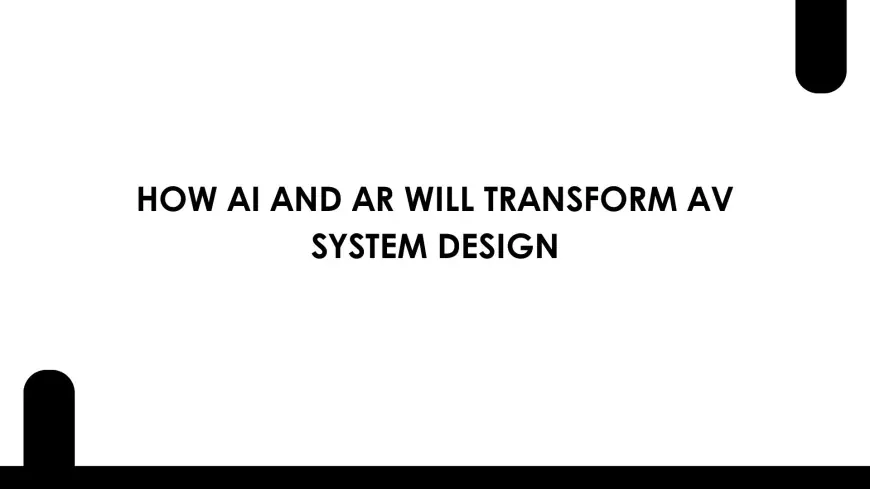How AI and AR Will Transform AV System Design
This blog explores how AI and AR are changing the landscape of AV system design, from automated schematics to interactive visualizations, and why AV professionals are embracing these tools to deliver better results.

XTEN-AV has been at the forefront of integrating technology to simplify and enhance AV system design. As audio visual systems become more complex and client expectations rise, traditional design methods are increasingly insufficient. The combination of artificial intelligence (AI) and augmented reality (AR) is poised to revolutionize the AV industry, making design faster, more accurate, and more immersive.
This blog explores how AI and AR are changing the landscape of AV system design, from automated schematics to interactive visualizations, and why AV professionals are embracing these tools to deliver better results.
The Current State of AV System Design
Traditionally, AV system design relies on manual planning, CAD drafting, and physical site surveys. Designers must consider device placement, rack layouts, cabling, power distribution, and environmental factors such as lighting and acoustics. While these methods work, they are time consuming, prone to human error, and often require multiple iterations to meet client expectations.
Moreover, clients frequently struggle to visualize the final setup from 2D schematics or static renderings. Misunderstandings about system performance, speaker coverage, or video display positioning can lead to costly changes during installation.
Artificial Intelligence in AV Design
AI powered tools like XTEN-AV are already changing how AV systems are designed. Artificial intelligence can analyze room dimensions, acoustics, lighting conditions, and equipment specifications to provide intelligent recommendations for system layout. Key benefits include:
-
Automated Device Placement – AI can suggest optimal positions for speakers, displays, microphones, and other equipment to maximize performance.
-
Rack Layout Optimization – Intelligent algorithms determine the best arrangement for devices in racks, considering airflow, weight distribution, and accessibility.
-
Cable Management and Power Planning – AI automatically routes cables, assigns devices to circuits, and plans redundancy for critical systems.
-
Error Reduction – By analyzing specifications and connections, AI reduces human errors that could compromise system performance.
By automating repetitive and calculation heavy tasks, AI allows AV professionals to focus on creative design decisions and client engagement.
The Role of Augmented Reality
While AI handles the intelligence behind design, AR brings the visualization component to life. Using AR headsets or mobile devices, designers and clients can walk through a physical space and see virtual representations of AV systems in real time. This has several advantages:
-
Interactive Visualization – Clients can see exactly where speakers, displays, and control panels will be located, making it easier to provide feedback.
-
Spatial Accuracy – AR ensures devices fit the space and allows designers to adjust positions dynamically to avoid obstructions or optimize coverage.
-
Training and Simulation – Installation teams can use AR to familiarize themselves with the layout before physically handling equipment, reducing installation errors.
-
Enhanced Collaboration – Multiple stakeholders can view the AR environment simultaneously, providing a shared understanding of system design.
AR bridges the gap between conceptual plans and the physical environment, making communication between designers, integrators, and clients more effective.
How AI and AR Work Together
The combination of AI and AR creates a powerful workflow for AV system design:
-
Design Generation – AI analyzes the space and generates an initial system layout, including rack arrangements, device placement, and cabling routes.
-
Interactive Visualization – AR projects the AI generated layout into the physical environment, allowing designers and clients to explore the space virtually.
-
Real-Time Adjustments – Clients and designers can move devices, tweak orientations, or swap equipment in the AR view, with AI updating specifications and performance metrics automatically.
-
Final Documentation – Once the design is approved, AI generates complete schematics, rack elevation drawings, and installation guides.
This integrated workflow reduces errors, saves time, and improves client satisfaction by providing both intelligent design and immersive visualization.
Benefits for AV Professionals
Faster Design Cycles
AI and AR significantly reduce the time required for planning and approvals. Instead of weeks of manual drafting and client revisions, designers can generate proposals and validate them interactively in a matter of hours.
Improved Accuracy
AI ensures that system calculations, device placement, and power distribution are accurate, reducing costly mistakes during installation. AR allows designers to verify spatial alignment and equipment accessibility in the real world.
Enhanced Client Communication
AR allows clients to see and experience the AV system before installation, providing clarity and reducing miscommunication. Clients can make informed decisions and approve designs confidently.
Cost Efficiency
By minimizing rework, optimizing equipment placement, and reducing design iterations, AI and AR help projects stay within budget and reduce installation time.
Applications Across Industries
Houses of Worship
Churches, mosques, and temples benefit from AI and AR by designing systems that deliver clear speech, immersive audio, and visually engaging presentations while accommodating unique architecture.
Corporate Environments
Boardrooms and auditoriums can be designed with precise speaker coverage, projection positioning, and rack layouts that optimize productivity and reduce downtime.
Entertainment Venues
Concert halls, theaters, and sports arenas require complex AV systems. AI and AR help designers plan large scale deployments with accurate acoustics and sightlines.
Educational Institutions
Classrooms, lecture halls, and auditoriums benefit from optimized audiovisual layouts that enhance student engagement and minimize installation challenges.
The Future of AV System Design
As AI and AR technologies continue to evolve, we can expect even more advanced capabilities in AV design. Predictive performance simulations, real-time environmental adjustments, and AI guided maintenance recommendations will become standard. The integration of IoT and machine learning will allow AV systems to self optimize for acoustics, video quality, and energy efficiency.
In this future, AV professionals will spend less time on repetitive tasks and more time on innovation, client engagement, and system optimization. The collaboration between AI and AR will ensure designs are not only efficient and accurate but also immersive and highly interactive.
Conclusion
AI and AR are transforming the AV industry, making system design faster, more accurate, and more immersive. XTEN-AV is at the forefront of this transformation, providing tools that automate AV Rack layout design, optimize device placement, and allow real-time AR visualization.
By combining intelligent automation with interactive visualization, AV professionals can streamline workflows, reduce errors, and deliver superior results for clients across houses of worship, corporate environments, entertainment venues, and educational institutions.
The future of AV system design is not just about technology; it is about integrating AI and AR to create smarter, more efficient, and highly engaging audiovisual experiences.
Read more: https://bizdirectoryhub.com/from-proposal-to-rack-design-how-ai-simplifies-the-av-workflow/
What's Your Reaction?
 Like
0
Like
0
 Dislike
0
Dislike
0
 Love
0
Love
0
 Funny
0
Funny
0
 Angry
0
Angry
0
 Sad
0
Sad
0
 Wow
0
Wow
0

















































